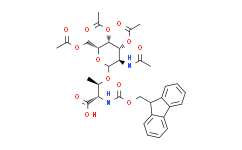| Cas No.: | 116783-35-8 |
| Chemical Name: | Fmoc-Thr(galnac(Ac)3-alpha-D)-OH |
| Synonyms: | Fmoc-Thr(galnac(Ac)3-alpha-D)-OH;N-Fmoc-O-beta-(2-acetamido-2-deoxy-3,4,6-tri-O-acetyl-alpha-D-galactopyranosyl)-L-threonine;N-Alpha-(9-Fluoroenyloxycarbonyl)-o-(2-Acetamido-2Deoxy-3,4,6-Tri-o-Acetyl-Alpha-d-Galactopyranosyl)-l-Threonine;N-Fmoc-O-[3,4,6-tri-O-acetyl-2-(acetylamino)-2-deoxy-α-D-galactopyranosyl]-L-threonine;(N-alpha-Fmoc-O-beta-(2-acetamido-2-deoxy-3,4,6-tri-O-acetyl-alpha-D-galactopyranosyl)-L-threonine);Fmoc-Thr(Ac₃AcNH-α-Gal)-OH;Fmoc-Thr(GalNAc(Ac)?-α-D)-OH;Fmoc-Thr(GalNAc(Ac)3-a-D)-OH;N-FMOC-O-(2-ACETAMIDO-3,4,6-TRI-O-ACETYL-2-DEOXY-A-D-GALACTOPYRANOSYL)-L-THEREONINE;FMOC-THR(GALNAC(AC)3-α-D)-OH;Fmoc-Thr[GalNAc(Ac)3-α-D]-OH;Fmoc-O-β-(2-acetamido-2-deoxy-3,4,6-tri-O-acetyl-α-D-galactopyranosyl)-L-threonine;GalNAc-Thr;GALNAC L-THREONINE;FMOC-L-THR(TNAC4)-OH;FMoc-Thr-(Ac3AcNH-α-Gal)-OH;FMOC-Thr(GalNAc(Ac)3-α-D)-OH;FMoc-Thr(α-D-GalNAc(Ac)3)-OH;FMOC-THR(AC3ACNH-ALPHA-GAL)-OH;Fmoc-L-Thr(α-D-GalNAc(Ac)3)-OH;Fmoc-L-Ser(α-D-GalNAc(Ac)3)-OH |
| SMILES: | CC(OC[C@H]1OC(O[C@@H]([C@H](NC(OCC2C3=CC=CC=C3C3=CC=CC=C23)=O)C(=O)O)C)[C@H](NC(=O)C)[C@@H](OC(=O)C)[C@H]1OC(=O)C)=O |
| Formula: | C33H38N2O13 |
| M.Wt: | 670.660430431366 |
| Purity: | >98% |
| Sotrage: | 2 years -20°C Powder, 2 weeks 4°C in DMSO, 6 months -80°C in DMSO |
| Description: | Fmoc-Thr[GalNAc(Ac)3-α-D]-OH i a building block in the development of cancer vaccine |
| In Vitro: | The O-glycosidic linkage and the O-acetyl protection in this building block is stable to both piperidine and TFA, making it completely compatible with standard protocols in Fmoc solid phase peptide synthesis. The Tn antigen is a tumor-associated carbohydrate antigen that is not normally expressed in peripheral tissues or blood cells. Expression of this antigen, which is found in a majority of human carcinomas of all types, arises from a blockage in the normal O-glycosylation pathway in which glycans are extended from the common precursor GalNAcα1-O-Ser/Thr (Tn +antigen). This precursor is generated in the Golgi apparatus on newly synthesized glycoproteins by a family of polypeptide α- N-acetylgalactosaminyltransferases (ppGalNAcTs) and then extended to the common core 1 O-glycan Galβ1-3GalNAcα1-OSer/Thr (T antigen) by a single enzyme termed the T-synthase (core 1 β3-galactosyltransferase or C1GalT). Formation of the active form of the T-synthase requires a unique molecular chaperone termed Cosmc, encoded by Cosmc on the X-chromosome[1]. |
| References: | [1]. Ju T, et al. The Cosmc connection to the Tn antigen in cancer. Cancer Biomark. 2014 Jan 1;14(1):63-81. |

 To enhance service speed and avoid tariff delays, we've opened a US warehouse. All US orders ship directly from our US facility.
To enhance service speed and avoid tariff delays, we've opened a US warehouse. All US orders ship directly from our US facility.




















